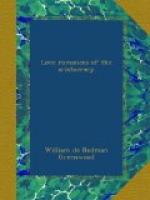Bursting with rage and indignation, father and son rushed up the stairs and demanded that Fitzgerald should come out. When he refused with oaths, they broke in the door—and found themselves face to face with a brace of pistols. Before they could be used, however, Colonel King, stooping suddenly, made a dash at Fitzgerald, closed with him, and was at once engaged in a life and death struggle. Backward and forward the combatants swayed, straining every muscle to bring their pistols into play for the fatal shot. By an almost superhuman effort, Fitzgerald at last wrested his right arm free. His pistol was pointed at the Colonel’s head. But before he could press the trigger, a shot rang out, and he fell back dead, shot through the heart. Lord Kingsborough had killed his daughter’s betrayer to save his son’s life.
The news of the tragedy flew throughout the country, in all the distorted forms that such news assumes on passing from mouth to mouth. But wherever it travelled—from the shebeens of Connemara to the coffee-houses of Cheapside—it carried with it a wave of compassion for the assassin and execration for his victim. As for Lord Kingsborough, he confessed to a friend: “God knows, I don’t know how I did it; but I wish it had been done by some other hand than mine!”
As was inevitable, the Viscount and his son were arrested on a charge of murder. Colonel King was tried at the Cork Assizes, and acquitted to a salvo of deafening cheers, as there was no prosecution. For Lord Kingsborough a different escape was reserved. Before he could be brought to trial at Cork, his father, the Earl of Kingston, died, and the Viscount became an Earl, with all the privileges of his rank—including that of trial by his Peers.
In May 1798, a month after his son’s acquittal, Lord Kingston’s trial took place in the House of Lords, with all the state and ceremony appropriate to this exalted tribunal. Preceded by the Masters in Chancery, the judges in scarlet and ermine, by the minor lords and a small army of eldest sons, the Peers filed in long and stately procession into the House, followed by the Lord High Steward, the Earl of Clare, walking alone in solitary dignity.
Then began the trial, with all its quaint and dignified ceremonial; and Robert, Earl of Kingston, pleaded “Not Guilty,” and claimed to be tried “by God and my Peers.” But the trial, which drew thousands to Westminster, was of short duration. To the demand that “all manner of persons who will give evidence against the accused should come forth,” no response was given. Not a solitary witness for the Crown appeared. One by one the Peers pronounced their verdict, “Not Guilty, upon my honour”; the Lord Steward broke his white staff; and amid a crowd of congratulating friends, the Earl walked out a free man.




